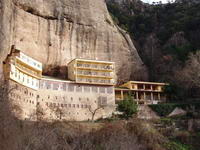
The Great Cave
 |
The eight-story high Holy Monastery of the Great Cave was built literally onto a rugged vertical mountain face, at an altitude of 930m. It was established by two monks from Thessaloniki, Symeon and Theodore. After a vision they had had, the two monks sought out the icon of the Virgin Mary (Panagia) that had appeared in their vision painted in relief. After wandering about the land in pursuit of the icon for a long time, in 362 AD, they finally reached the village of Zachlorou in Achaia. There, they were led by the shepherdess Euphrosini to a cave where she had just discovered the sacred icon the two monks had been looking for.
The Monastery was first destroyed in 840 by the iconoclasts. It was again destroyed in 1460 and in 1640 by the Turks. In 1934, it was ravaged by fire and, in 1943, it was razed by Nazi occupation forces.
The relief icon of Panagia Chrysospiliotissa (Our Lady of the Golden Cave) is still to be seen in the Monastery of the Great Cave (‘Mega Spilaeo’). It is made of wax, fragrant substances, and mastic and is said to be one of the four icons painted by Lucas the Evangelist. The church is decorated with remarkable frescoes dating to 1600 and houses manuscripts, gospel books, and reliquaries.